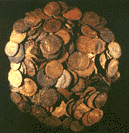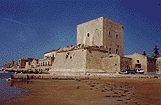| |
 POZZALLO POZZALLO Pozzallo was the
favourite landing place of Roman and Byzantine ships. The
ships used to draw in to the pier and take fresh water
from the numerous wells in the town. This was the town of
the V century B.C, but Pozzallo is still today one of the
most important landing places in East Sicily. Its harbour
is a big facility used by the whole province, thousands
of visitors land in this harbour, every year tons of raw
materials and goods from the industrious Hyblaean land
are shipped from here. It is the only Municipality of the
province which stands on the seabord, in a coast between
the Mediterranean sea and the valleys of the Hyblaean
plateau. The coast spreads out from Punta Raganzino to
the shores of Marza. The etymology of Marza comes from
the name which the Arab Historian Edrisi, who lived in
the XII century choose for Pusalo: Marsa As Deramini,
that is "harbour of Dromons ". The dromons were
the Christian galleys which threw Greek fire: a mixture
of saltpetre, sulphur and pitch against the Muslim ships
which raided the Mediterranean sea. Pozzallo was the
favourite landing place of Roman and Byzantine ships. The
ships used to draw in to the pier and take fresh water
from the numerous wells in the town. This was the town of
the V century B.C, but Pozzallo is still today one of the
most important landing places in East Sicily. Its harbour
is a big facility used by the whole province, thousands
of visitors land in this harbour, every year tons of raw
materials and goods from the industrious Hyblaean land
are shipped from here. It is the only Municipality of the
province which stands on the seabord, in a coast between
the Mediterranean sea and the valleys of the Hyblaean
plateau. The coast spreads out from Punta Raganzino to
the shores of Marza. The etymology of Marza comes from
the name which the Arab Historian Edrisi, who lived in
the XII century choose for Pusalo: Marsa As Deramini,
that is "harbour of Dromons ". The dromons were
the Christian galleys which threw Greek fire: a mixture
of saltpetre, sulphur and pitch against the Muslim ships
which raided the Mediterranean sea.
 The History The History
It was the archaeologist Paolo
Orsi, a great discoverer of prehistoric Sicily, who
brought to light the findings proving the Roman and
Byzantine  presence
in the territory. The inviting geographical position of
this nucleus encouraged settlements since the most remote
ages. Burial grounds and Roman coins have been
discovered. "Pozzallo" means " a well at presence
in the territory. The inviting geographical position of
this nucleus encouraged settlements since the most remote
ages. Burial grounds and Roman coins have been
discovered. "Pozzallo" means " a well at  the
seaside" but the most ancient name is Pausis alos
which means "landing at the sea" which was then
changed to Pussalo. After the Saracen’s
domination the ancient etymology was kept until the
fifteenth century when in a document was mentioned the
name "Alpusalli" which all over the centuries
has undergone various phonetic transformations up to the
final term sanctioned by the Chart of the Reign of Sicily
in 1721. the
seaside" but the most ancient name is Pausis alos
which means "landing at the sea" which was then
changed to Pussalo. After the Saracen’s
domination the ancient etymology was kept until the
fifteenth century when in a document was mentioned the
name "Alpusalli" which all over the centuries
has undergone various phonetic transformations up to the
final term sanctioned by the Chart of the Reign of Sicily
in 1721.
 The Cabrera Tower: " The petrified
Sentry" The Cabrera Tower: " The petrified
Sentry"
This terrace sloping down to the
sea, called the "petrified sentry" of the
Mediterranean is the symbol of Pozzallo and it is the
only architectural trace of the fifteenth century which
is proudly standing. Among all the ramparts built to
contrast the Saracen’s invasions of the Hyblaean
territory the Cabrera tower was the most imposing and the
best fo rtified
one. It was built in 1492 by the Earl of Modica Don
Giovanni Bernardo Cabrera who put into practise his
father’s idea to erect a military tower to protect
the inhabitants; the King of Sicily Alphonso V of Aragon
gave his assent for this project Nearby the tower there
was once a landing place for merchant ships about which
the Sicilian historian Tommaso Fazello writes:
"… a very big tower made by Bernardo Incaprera,
which is called Pozzallu and is lapped on by the sea, a
lot of wheat is shipped from here and only sixty miles
separate this land from Malta". The tower keeper was
the Master of the Port, hard and merciless when he
carried out his administrative duties; he separated the
wheat destined to people from the wheat destined to the
tax payment for the county; but he could even be generous
with the lords of the manors. The severe structure of the
tower and the landing place reflected the atmosphere of
fear and resignation but were also the symbol of economic
progress and a spur to increase trade and cultural and
economical exchanges. rtified
one. It was built in 1492 by the Earl of Modica Don
Giovanni Bernardo Cabrera who put into practise his
father’s idea to erect a military tower to protect
the inhabitants; the King of Sicily Alphonso V of Aragon
gave his assent for this project Nearby the tower there
was once a landing place for merchant ships about which
the Sicilian historian Tommaso Fazello writes:
"… a very big tower made by Bernardo Incaprera,
which is called Pozzallu and is lapped on by the sea, a
lot of wheat is shipped from here and only sixty miles
separate this land from Malta". The tower keeper was
the Master of the Port, hard and merciless when he
carried out his administrative duties; he separated the
wheat destined to people from the wheat destined to the
tax payment for the county; but he could even be generous
with the lords of the manors. The severe structure of the
tower and the landing place reflected the atmosphere of
fear and resignation but were also the symbol of economic
progress and a spur to increase trade and cultural and
economical exchanges.
Today the tower holds, in its old age stones, centuries
of history and soon its rooms, recently restored and
unknown until yesterday, will be open to the public .
 The town The town
"Pozzallo is a town
full of terraces……Terraces! With tile or cement
floors and iron railings, silent and modest witnesses of
summer and country blazes, witnesses of the joy of
bystanders and the looks of passers-by "(Raffaele
Poidomani, 1954)
The most beautiful place of the
town planning scheme is Piazza delle Rimembranze, with
its Mediterranean palm-trees drawing the perimeter of the
square and decorating the twentieth century palaces that
look on to it. We can see the beautiful Liberty buildings
and the 1845 Palazzo Musso, with its arcades, that opens
on the square on the one side and to the the Tower on the
other side, Palazzo Giunta with a balustraded terrace and
the 1868 Palazzo Pandolfi.
|